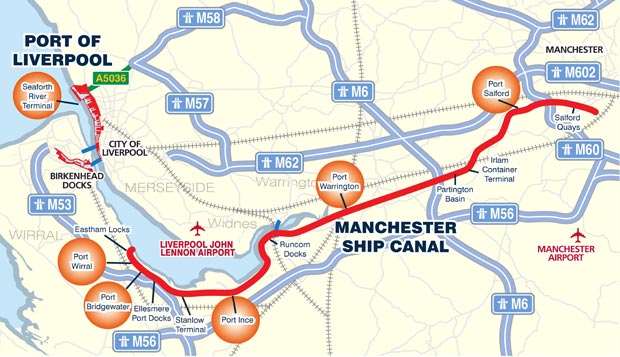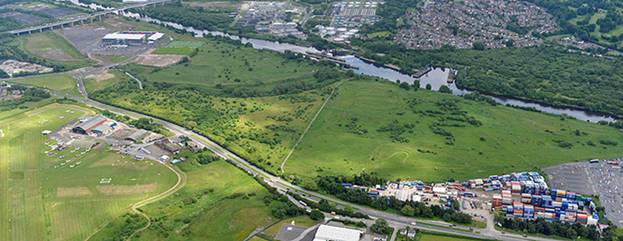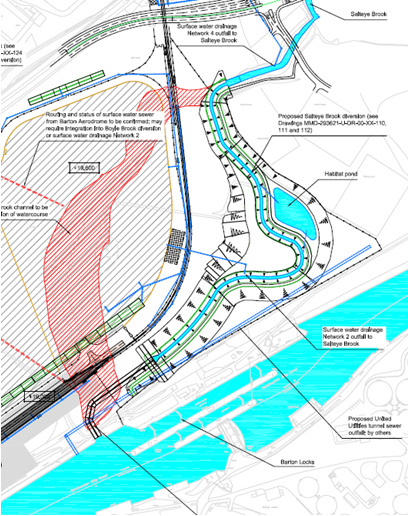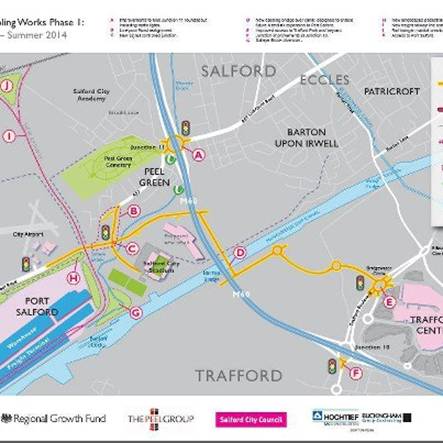Port Salford |
|
Interim Client & Design Award
Project Team
Client: Peel Investments (North) Ltd
Designer: Mott McDonald Ltd (Lead designer), Jacobs (Rail), TEP, Capita Symonds, Buro Happold, White Young Green, Gleeds
The Project
Recognised by the UK National Infrastructure Plan, Port Salford aims to be the UK’s first tri-modal port facility accessible via an in-land waterway. Adjacent to the Manchester Ship Canal, it is a critical component of the Atlantic Gateway development, with Peel Investments North as the main private sector partner (client). Providing a distribution base working in conjunction with Port of Liverpool, it will improve supply chain access for businesses across the UK. It enables direct barge access to the river terminal at Port of Liverpool and reduces the environmental impact of the terminal’s expansion by reducing freight volumes on UK road infrastructure.
In particular, this strategy will significantly reduce the cost of import and export for northern companies and consumers. By utilising the Port of Liverpool, Manchester Ship Canal and Port Salford rather than southern ports, over 150 million road miles could be saved; realising a significant congestion benefit and carbon saving of 80 million kilograms per annum.

Site location
The Port Salford proposals consist of a tri-modal inland port facility and distribution park on the outskirts of Manchester in Salford.
The development site totals 160 acres (65 hectares) and is bounded by the Manchester Ship Canal. It is situated in a superb location close to the M60 and M62 motorways offering easy access to the North West and the remainder of the UK-wide motorway network. The site is approximately 1 mile from Junction 11 of the M60, Manchester's orbital motorway.

Port Salford also benefits from rail access to the West Coast Main Line and direct access; further enhancing the appeal for distribution companies to be located there. The site will be connected to the Manchester-Liverpool railway line, and to the West Coast Main Line, enabling freight trains to access both the warehousing and container terminal. The terminal will benefit from berths on the Manchester Ship Canal enabling ships of 500 TEU capacity to load and discharge at the site.
The Development
Port Salford will be a multi-modal freight terminal and will offer warehouse occupants a full range of freight options at one integrated facility. Planning permission has been granted for approximately 1.7 million sq. ft (157,936 sq. metres) of rail-served distribution warehousing, rail link and sidings and intermodal and ancillary facilities (including a canal quay). It will be a National Import Centre where goods will arrive by water and rail to be distributed to local centres by rail and road. It is predicted to generate some 3,858 gross permanent jobs, as well as lower logistics costs for businesses across the UK

Influence of CEEQUAL
All sections within CEEQUAL scored well and some of the features of those sections that scored highest are described here.
Ecology & Biodiversity
Full credits were awarded under the Ecology & Biodiversity section. In addition to conserving as much as possible of the existing biodiversity value on site within the development plans, significant ecological enhancements have been specified by the design team. In particular, a realignment of the Salteye Brook represents an opportunity to enhance the biodiversity potential of this watercourse. A scheme has been proposed to incorporate marginal habitats prone to flooding, permanent ponds, wetland planting, woodland planting and the use of bank profiles attractive to water vole, with all seeding and planting to be native and of local provenance where possible.
In addition to measures recommended for the main habitat enhancement areas, a number of site wide measures have also been specified:
- 80% of all tree planting and 50% of all new shrub planting should be native;
- Swathes of bulb planting should be included within the scheme;
- 50no. bat boxes and 50no. bird boxes should be erected on new buildings or retained mature trees within the site;
- Use of green trellises and native or wildlife-friendly climbing species should be included on new buildings and walls within the development;
- Good horticultural practices should be implemented within the site planting scheme; e.g. use peat-free composts and mulches and application of non-residual pesticides.

Salteye Brook realignment
Water
The use of SuDS techniques have been incorporated as much as feasible in the scheme in order to ensure water quality improvements and that flood risk downstream of the site is not increased as a result of the new development. Flow control devices have been placed at strategic points within each network to restrict flows to the required rate of greenfield run-off. To prevent flooding occurring as a result of the imposed flow restrictions, attenuation storage facilities have also been incorporated into the design of the new systems to store the excess flood volumes. These attenuation facilities include swales, ponds and oversized pipes, which will be integrated into the finished landscaping design for the site. The primary attenuation storage facility comprises an 800 metre long swale located between the wharf and container handling/tenanted warehouse areas. Two further swales and two attenuation ponds are also required to store exceedence flows.
Land-use
Minimising the effects of the construction process on the environment has also been a key consideration in the design development. The amount of cut and fill required for the whole site has been balanced in order to ensure that no extra materials need to be brought in from external sources and that waste is minimised. The Salteye Brook diversion forms a major component of this since it will require major excavation works to construct. The spoil removed from the new diversion channel will be used for filling on the site or following stockpiling to infill the existing channel and create the required formation level for the port itself.
Transport
The rationale for the project is based on the reduction of HGV road transport and associated carbon emissions. In addition, to the strategic aims of the project the proposals contain a number of more local/site transport initiatives. The Western Gateway Enabling Scheme (WGES) includes a series of essential transportation works to improve access to the site and surrounding areas including M60 junction improvements, a new dual carriageway link and a new bridge crossing over the Manchester Ship Canal. This major road and highway improvement programme will improve local transport connections, reduce congestion and help set up the development of phase one of Port Salford. In particular, it will provide an additional link to the A57 which will divert traffic away from local residential areas.
Other transport initiatives include increased pedestrian and public transport facilities to the site and the proposed use of the canal during the construction stage to move materials and equipment.


